Preparation and Properties of Thermoregulated Seaweed Fibers Based on Magnetic Paraffin wax@calcium Carbonate Microcapsules
Abstract
:1. Introduction
2. Materials and Methods
2.1. Materials
2.2. Preparation of Magnetic PW@CaCO3 Phase Change Microcapsules with Different Fe3O4 Mass Fractions
2.3. Preparation of Thermoreguhlated Seaweed Fiber
2.4. Characterization and Measurement
3. Results
3.1. Preparation Mechanism of Thermoregulated Seaweed Fibers
3.2. Surface Morphology Analysis of Microcapsules
3.3. Analysis of Chemical Structure, Thermal, and Magnetic Properties of Microcapsules
3.4. Physical and Surface Morphology Analysis of Seaweed Fibers
3.5. Analysis of Thermal Energy Storage Properties of Thermoregulated Seaweed Fibers
4. Conclusions
- (1)
- Summary of Findings: Magnetic PW@CaCO3 phase change microcapsules were successfully synthesized using a self-assembly method, integrating PW as the phase change core and a hybrid shell composed of CaCO3 and Fe3O4 nanoparticles. Characterization revealed that with an 8% mass fraction of Fe3O4 nanoparticles, the microcapsules exhibited a saturation magnetization of 2.44 emu/g and a thermal enthalpy of 94.25 J/g, highlighting their effective magnetic and thermal storage properties. Thermoregulated seaweed fibers, incorporating SA, PVA, and the magnetic phase change microcapsules, were fabricated through wet spinning. These fibers demonstrated a melting enthalpy of 19.8 J/g, significantly higher than pure seaweed fibers, with phase change behavior sustained for up to 8 min during heating.
- (2)
- Limitations: Despite these advancements, several limitations were identified. The primary limitation is the potential variability in the thermal performance of the fibers due to inconsistencies in the dispersion of Fe3O4 nanoparticles. Additionally, the scalability of the wet spinning process for large-scale production remains a challenge. The long-term stability of the microcapsules under repeated thermal cycles has not been thoroughly tested.
- (3)
- Future Work: Future research should focus on optimizing the dispersion of nanoparticles to enhance uniformity and performance. Investigating alternative methods for large-scale production and evaluating the long-term durability of the phase change materials under extended thermal cycling are also recommended. Additionally, exploring the integration of these materials into diverse textile applications could further demonstrate their practical benefits.
Author Contributions
Funding
Institutional Review Board Statement
Informed Consent Statement
Data Availability Statement
Conflicts of Interest
References
- Luo, L.; Luo, W.; Chen, W.; Hu, X.; Ma, Y.; Xiao, S.; Li, Q.; Jiang, X. Form-stable phase change materials based on graphene-doped PVA aerogel achieving effective solar energy photothermal conversion and storage. Sol. Energy 2023, 255, 146–156. [Google Scholar] [CrossRef]
- u Mekrisuh, K.; Giri, S.; Udayraj; Singh, D.; Rakshit, D. Optimal design of the phase change material based thermal energy storage systems: Efficacy of fins and/or nanoparticles for performance enhancement. J. Energy Storage 2021, 33, 102126. [Google Scholar] [CrossRef]
- Liu, X.; Yang, F.; Li, M.; Sun, C.; Wu, Y. Development of cost-effective PCM-carbon foam composites for thermal energy storage. Energy Rep. 2022, 8, 1696–1703. [Google Scholar] [CrossRef]
- Chen, H.; Xuan, J.; Deng, Q.; Gao, Y. WOOD/PCM composite with enhanced energy storage density and anisotropic thermal conductivity. Prog. Nat. Sci. Mater. Int. 2022, 32, 190–195. [Google Scholar] [CrossRef]
- Reyes, G.; Ajdary, R.; Yazdani, M.R.; Rojas, O.J. Hollow filaments synthesized by dry-jet wet spinning of cellulose nanofibrils: Structural properties and thermoregulation with phase-change infills. ACS Appl. Polym. Mater. 2022, 4, 2908–2916. [Google Scholar] [CrossRef] [PubMed]
- Kumar, D.M.; Chiranjib, B.; Sumit, B.; Murari, K.P. Property-enhanced paraffin-based composite phase change material for thermal energy storage: A review. Environ. Sci. Pollut. Res. 2022, 29, 43556–43587. [Google Scholar] [CrossRef]
- Aulakh, J.S.; Joshi, D.P. Thermal and morphological study of paraffin/SEBS/expanded graphite composite phase change material for thermal energy storage. Energy Sources Part A Recovery Util. Environ. Eff. 2022, 44, 986–1003. [Google Scholar] [CrossRef]
- Chen, S.; Zheng, Z.; Liu, H.; Wang, X. Highly efficient, antibacterial, and salt-resistant strategy based on carbon black/chitosan-decorated phase-change microcapsules for solar-powered seawater desalination. ACS Appl. Mater. Interfaces 2023, 15, 16640. [Google Scholar] [CrossRef] [PubMed]
- Zhao, L.; Wu, X.; Cao, Z.; Hu, X.; Zheng, S. Enhanced thermal conductivity of phase change microcapsules based on boron nitride/graphene oxide composite sheets. ACS Appl. Polym. Mater. 2023, 5, 3835–3847. [Google Scholar] [CrossRef]
- Zhang, H.; Wang, X.; Wu, D. Silica encapsulation of n-octadecane via sol-gel process: A novel microencapsulated phase-change material with enhanced thermal conductivity and performance. J. Colloid Interface Sci. 2010, 343, 246–255. [Google Scholar] [CrossRef] [PubMed]
- Maiti, T.K.; Dixit, P.; Suhag, A.; Bhushan, S.; Yadav, A.; Talapatra, N.; Chattopadhyay, S. Advancements in organic and inorganic shell materials for the preparation of microencapsulated phase change materials for thermal energy storage applications. RSC Sustain. 2023, 1, 665–697. [Google Scholar] [CrossRef]
- Liu, H.; Wang, X.; Wu, D. Innovative design of microencapsulated phase change materials for thermal energy storage and versatile applications: A review. Sustain. Energy Fuels 2019, 3, 1091–1149. [Google Scholar] [CrossRef]
- Wei, H.; He, F.; Li, Y.; Zhang, Q.; Zhou, Y.; Yan, H.; He, R.; Fan, J.; Yang, W. Bifunctional paraffin@ CaCO3: Ce3+ phase change microcapsules for thermal energy storage and photoluminescence. ACS Sustain. Chem. Eng. 2019, 7, 18854–18862. [Google Scholar] [CrossRef]
- Jiang, Z.; Yang, W.; He, F.; Xie, C.; Fan, J.; Wu, J.; Zhang, K. Modified phase change microcapsules with calcium carbonate and graphene oxide shells for enhanced energy storage and leakage prevention. ACS Sustain. Chem. Eng. 2018, 6, 5182–5191. [Google Scholar] [CrossRef]
- Ke, W.D.K.; Wu, X.W.; Zhang, J.L. In situ polymerization of organic and inorganic phase change microcapsule and enhancement of infrared stealth via nano iron. Colloids Surf. A Physicochem. Eng. Asp. 2021, 627, 127124. [Google Scholar] [CrossRef]
- Liu, X.; Wang, J.; Xie, H.; Guo, Z. Concurrent magnetic and thermal energy storage using a novel phase-change microencapsulated -nanoparticles fluid. J. Energy Storage 2022, 56, 105973. [Google Scholar] [CrossRef]
- Lu, B.; Zhang, Y.; Zhang, J.; Zhu, J.; Zhao, H.; Wang, Z. Preparation, optimization and thermal characterization of paraffin/nano-Fe3O4 composite phase change material for solar thermal energy storage. J. Energy Storage 2022, 46, 103928. [Google Scholar] [CrossRef]
- Liu, X.; Wang, J.; Xie, H.; Guo, Z. Self-assembled synthesis of microencapsulated paraffin wax phase change materials with excellent thermal properties of calcium carbonate shell. J. Enhanc. Heat Transf. 2023, 30, 1–18. [Google Scholar] [CrossRef]
- Tian, D.; Shi, T.; Wang, X.; Liu, H.; Wang, X. Magnetic field-assisted acceleration of energy storage based on microencapsulation of phase change material with CaCO3/Fe3O4 composite shell. J. Energy Storage 2022, 47, 103574. [Google Scholar] [CrossRef]
- Liu, H.; Tian, X.; Ouyang, M.; Wang, X.; Wu, D.; Wang, X. Microencapsulating n-docosane phase change material into CaCO3/Fe3O4 composites for high-efficient utilization of solar photothermal energy. Renew. Energy 2021, 179, 47–64. [Google Scholar] [CrossRef]
- Zhang, M.; Shen, H.; Qian, Z.; Liu, H.; Tian, D.; Wang, X. Dual-purpose applications of magnetic phase-change microcapsules with crystalline-phase-tunable CaCO3 shell for waste heat recovery and heavy metal ion removal. J. Energy Storage 2022, 55, 105672. [Google Scholar] [CrossRef]
- Wang, X.; Lei, W.; Zou, F.; Zhang, C.; Zhu, J. Synthesis and characterization of nano-Fe3O4 hybrid phase change microcapsules for infrared stealth and microwave absorption. J. Mater. Res. 2022, 37, 2335–2346. [Google Scholar] [CrossRef]
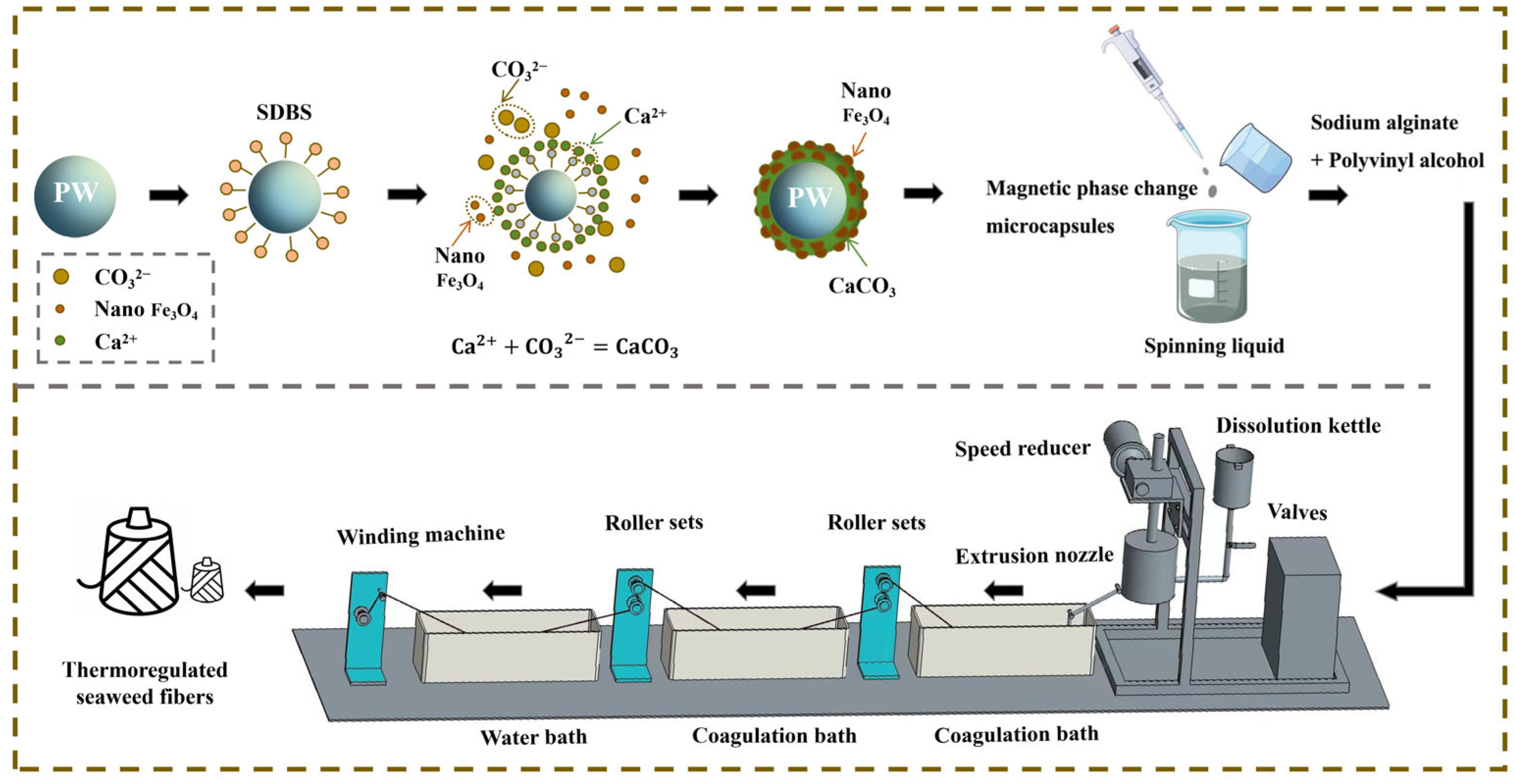
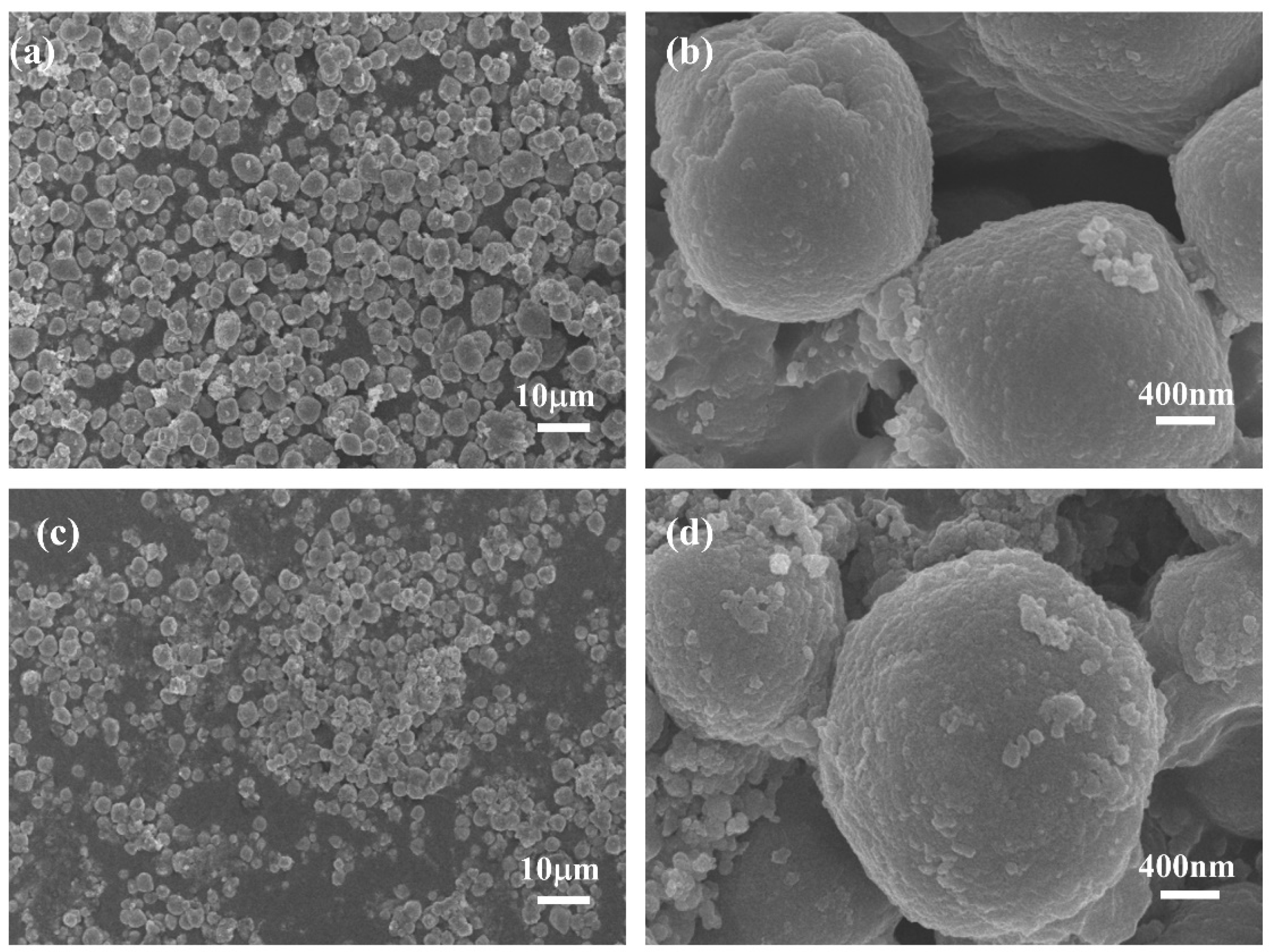
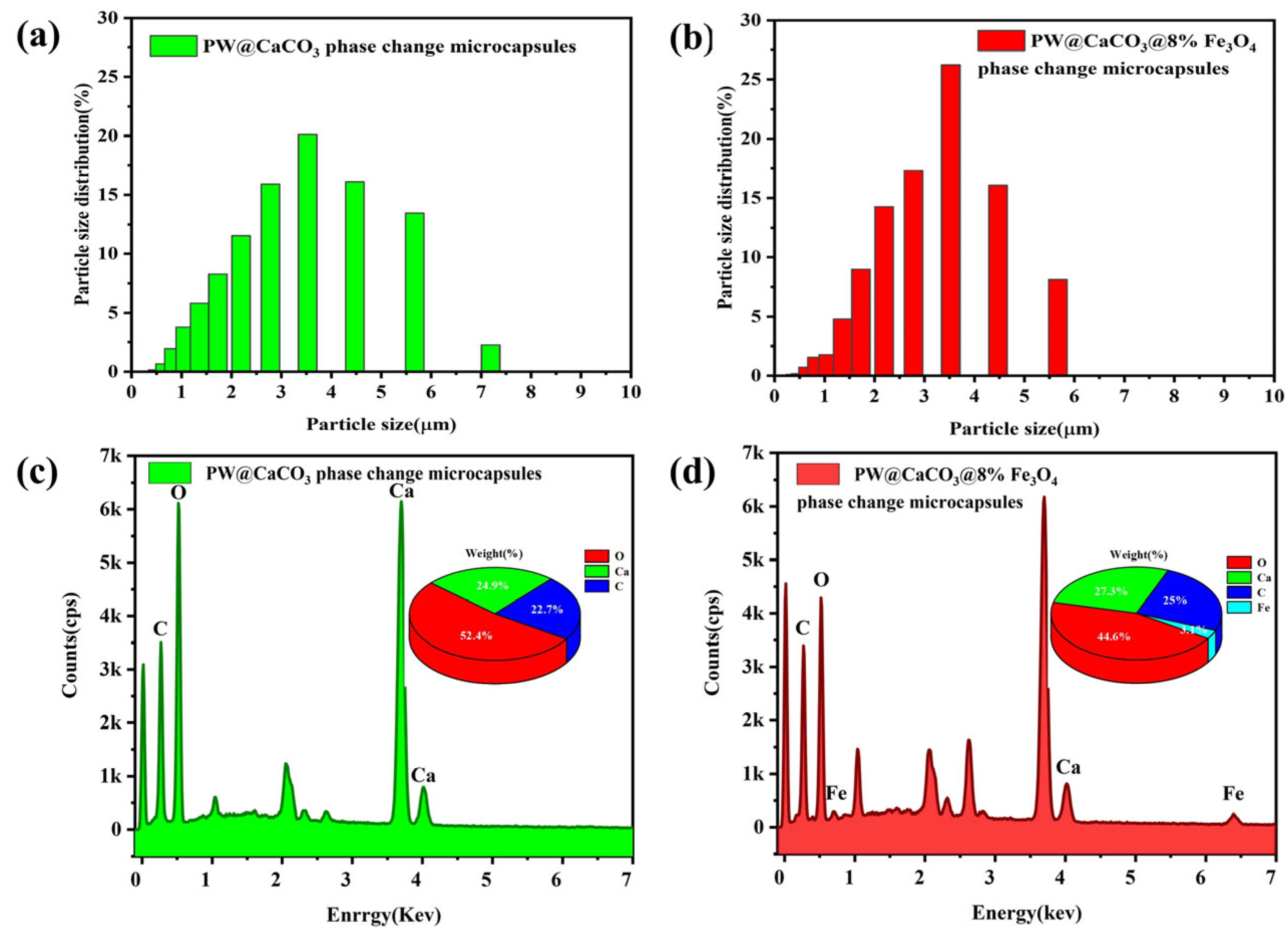

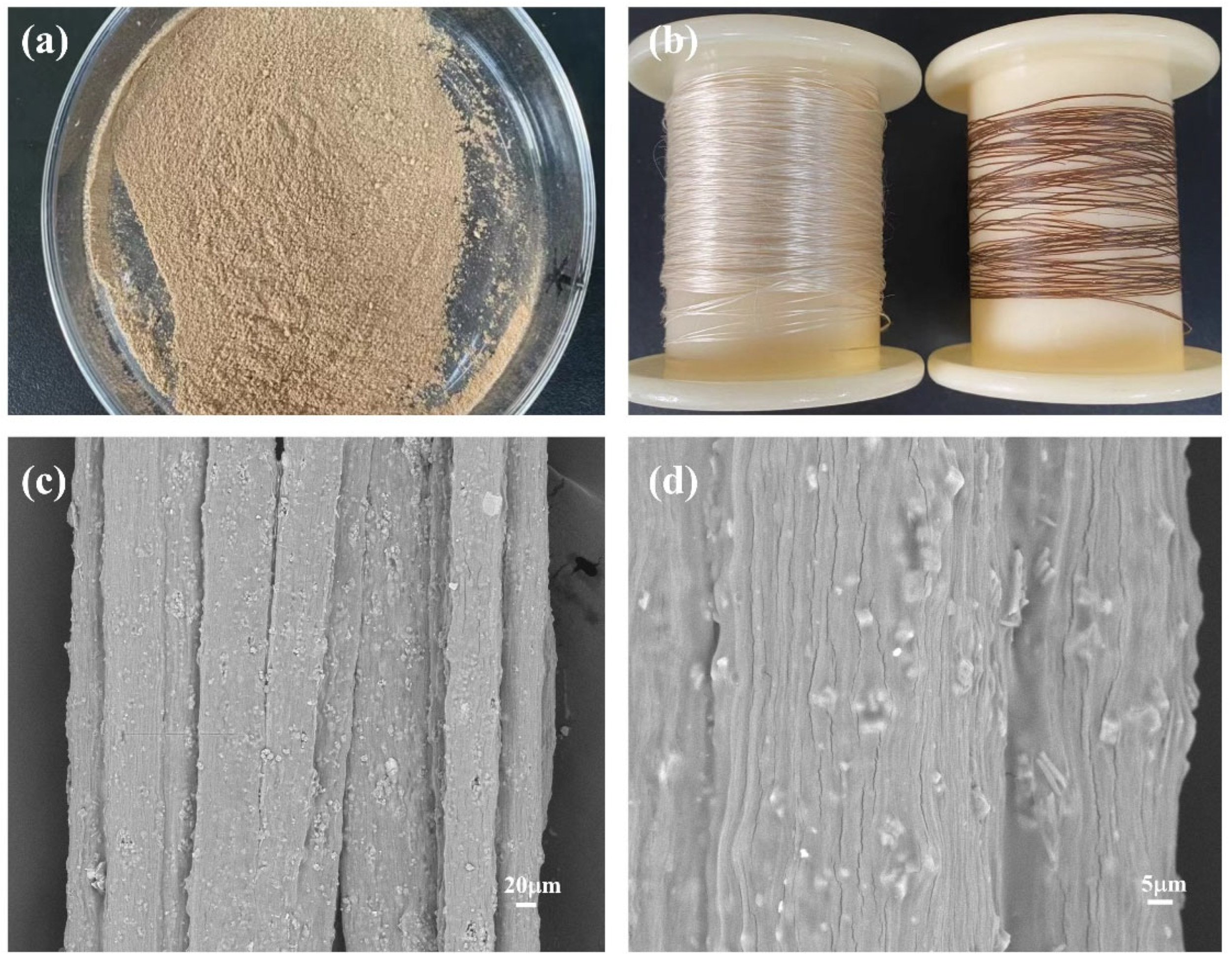

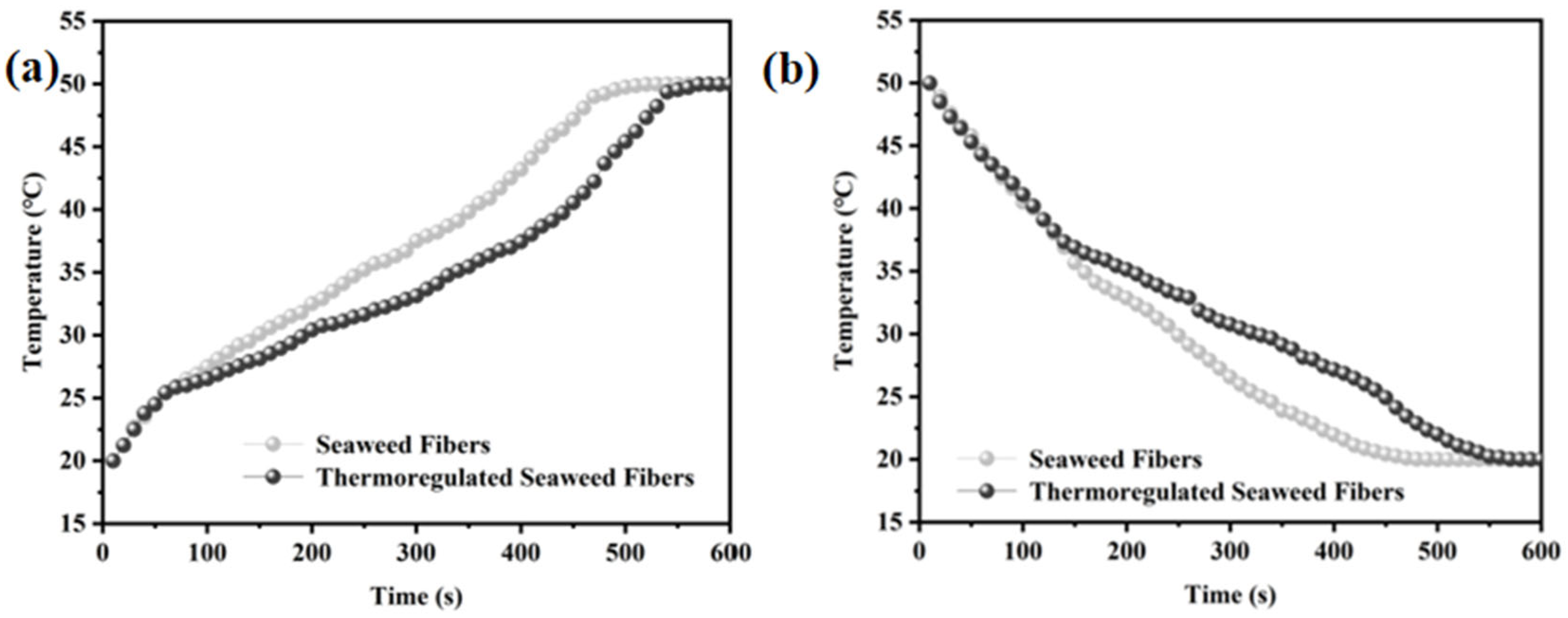
| Samples | Melting Process | Crystallization Process | ||
|---|---|---|---|---|
| Tm (°C) | ΔHm (J/g) | Tc (°C) | ΔHc (J/g) | |
| Seaweed fibers | / | 0 | / | 0 |
| Thermoregulated seaweed fibers | 30.5 | 19.8 | 26.0 | 19.55 |
Disclaimer/Publisher’s Note: The statements, opinions and data contained in all publications are solely those of the individual author(s) and contributor(s) and not of MDPI and/or the editor(s). MDPI and/or the editor(s) disclaim responsibility for any injury to people or property resulting from any ideas, methods, instructions or products referred to in the content. |
© 2024 by the authors. Licensee MDPI, Basel, Switzerland. This article is an open access article distributed under the terms and conditions of the Creative Commons Attribution (CC BY) license (https://creativecommons.org/licenses/by/4.0/).
Share and Cite
Li, Y.; Xu, C.; Lin, Y.; Song, X.; Sun, R.; Wang, Q.; Feng, X. Preparation and Properties of Thermoregulated Seaweed Fibers Based on Magnetic Paraffin wax@calcium Carbonate Microcapsules. Materials 2024, 17, 4826. https://doi.org/10.3390/ma17194826
Li Y, Xu C, Lin Y, Song X, Sun R, Wang Q, Feng X. Preparation and Properties of Thermoregulated Seaweed Fibers Based on Magnetic Paraffin wax@calcium Carbonate Microcapsules. Materials. 2024; 17(19):4826. https://doi.org/10.3390/ma17194826
Chicago/Turabian StyleLi, Yonggui, Congzhu Xu, Yuanxin Lin, Xiaolei Song, Runjun Sun, Qiang Wang, and Xinqun Feng. 2024. "Preparation and Properties of Thermoregulated Seaweed Fibers Based on Magnetic Paraffin wax@calcium Carbonate Microcapsules" Materials 17, no. 19: 4826. https://doi.org/10.3390/ma17194826





